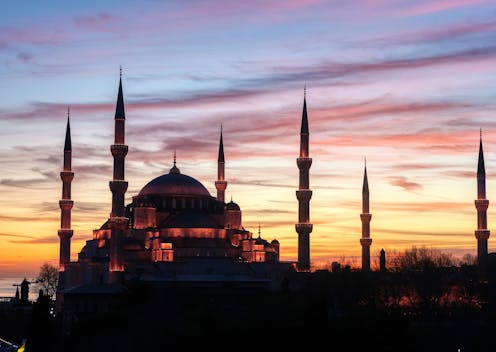
Much like Iraq in early 2003, the predominant images coming out of Syria in late 2024 were of jubilant crowds toppling statues of ousted dictators . In almost all the videos, the stone or metal of the sculpture raises a cloud of dust as it falls, blurring the view of the scene for a few moments.
Following the collapse of 61 years of Ba'ath Party dictatorship and 53 years of the al-Asad dynasty in Damascus, our view of the geopolitical lanscape in Syria and the Middle East is similarly obscured. We are still in the midst of the cloud lifted by the fall of a regime, trying to get a glimpse of how things will look once the dust settles.
However, there are some things we can confidently surmise. One is that Syria in 2024 may be to Turkey what Iraq was to Iran in 2003. When the US invaded Iraq in 2003 and overthrew the dictatorship of Saddam Hussein and the Iraqi Ba'ath Party, it also unwittingly got rid of a buffer state that had kept Iran’s regional ambitions in check for decades.
2003 marked the beginning of Tehran’s march towards hegemony in the Middle East, and the outbreak of the Arab Spring in 2011 accelerated this process. Iran’s regional power grew in tandem with destabilisation in various other countries, to the point where it eventually established a both direct and indirect presence (through Iranian-funded, trained and armed militias) in Lebanon, Gaza, Syria, Yemen and Iraq.
The so-called axis of resistance was nothing more than the alliance of the Iranian-backed factions in these countries. The first touchstone of this incipient hegemony was the land corridor to the Mediterranean: Iran-Iraq-Syria-Lebanon. The second was the ability to threaten the two most strategic straits in the region: Hormuz and Bab el-Mandeb (the latter via Yemeni Houthi rebel).
When Iran reached the height of its power
Between 2013 and 2017, Iran reached the zenith of its power in the Middle East. In particular, the signing of the 2015 nuclear deal granted it international clout, and put an end to the sanctions that had been crippling its economy.
In this expansionary phase, Iran sought to push the US out of the region, and to force countries such as Saudi Arabia and the Persian Gulf monarchies to keep a low profile and remain amiable to Tehran’s interests. It also built up a network with the aim of defeating Israel in a war of attrition.
Three leaders embodied this successful strategy of Iranian regional domination: Qasem Soleimani, creator of the axis of resistance; Mohsen Fakhrizadeh, father of the renewed nuclear programme; and Amir Ali Hajizadeh, responsible for the development of the missile and drone programme.
However, the high pressure campaign initiated by Donald Trump during his first term in office marked the beginning of Iran’s decline. Soleimani was assassinated in January 2020, and Fakhrizadeh in November 2020. The signing of the Abraham Accords, orchestrated by Trump in September 2020, also accelerated the decline of the Islamic Republic’s power in the region.
The destruction of Gaza, the defeat of Hezbollah in Lebanon and, most recently, the fall of al-Assad in Syria have been the final nails in the coffin for Iran’s strategic and hegemonic aspirations.
Turkey settles past scores
Geopolitics abhors a power vacuum. One country’s loss is another’s gain, and the space left by Iran is being occupied, for now, by Turkey. This should come as no surprise: the history of the Middle East between the 16th and 18th centuries was that of struggle between the Ottoman and Persian empires, and it seems to be reviving in the 21st century.
The Syria of al-Assad and the Ba'ath Party had acted as the buffer state to Tayyip Erdoğan’s Turkey, which, like Putin’s Russia, wants to settle scores with the past. While in Putin’s case, this is the fall of the Soviet Union 30 years ago, for Erdoğan it is the fall of the Ottoman Empire 100 years ago.
It is not that Russia or Turkey seek to regain direct rule over all the former territories of their imperial past, but they do seek to establish an area of influence over these territories. This would be based on the military occupation or occasional annexation of certain border regions (in the case of Turkey, northern Iraq and Syria). It also means establishing friendly governments in adjacent countries, and the creation of clientelistic networks through military and economic aid.
Ankara should be cautious in handling the triumph in Syria. Erdoğan and other members of his party will feel vindicated by the fall of Assad, as they, along with Qatar, have been the only Muslim countries in the Middle East to maintain firm opposition to the Assad regime. Even in recent years, when Assad seemed to have survived the civil war and Idlib rebel factions seemed increasingly weak, Turkey and Qatar maintained their support for the resistance.
It makes sense that Ankara is celebrating December’s quick and unexpected triumph. However, Erdoğan should also look to Pakistan. A few years ago, Pakistan’s state security apparatus was also celebrating the Taliban’s sudden and unexpected triumph after two decades on the ropes, and it was clear that without Islamabad’s support, the Taliban victory in Kabul would not have been possible. However, since the seizure of power, there has been increasing friction between the Taliban and Pakistan, leading to armed clashes on the border in recent weeks.
While Syrian rebels can be expected to maintain a deferential attitude towards Ankara, we can expect differences and disagreements to emerge in the future. To rescue the country from bankruptcy and misery, Damascus needs much more than what Turkey or Qatar alone can offer.
In its quest for regional hegemony, Turkey will face not only Iran, but also Saudi Arabia, the third major player in the Middle East that aspires to shape the region according to its interests. The outcome of the various conflicts currently gripping the region will be greatly influenced by how well these three countries can learn to coexist.
Javier Gil Guerrero no recibe salario, ni ejerce labores de consultoría, ni posee acciones, ni recibe financiación de ninguna compañía u organización que pueda obtener beneficio de este artículo, y ha declarado carecer de vínculos relevantes más allá del cargo académico citado.
This article was originally published on The Conversation. Read the original article.







